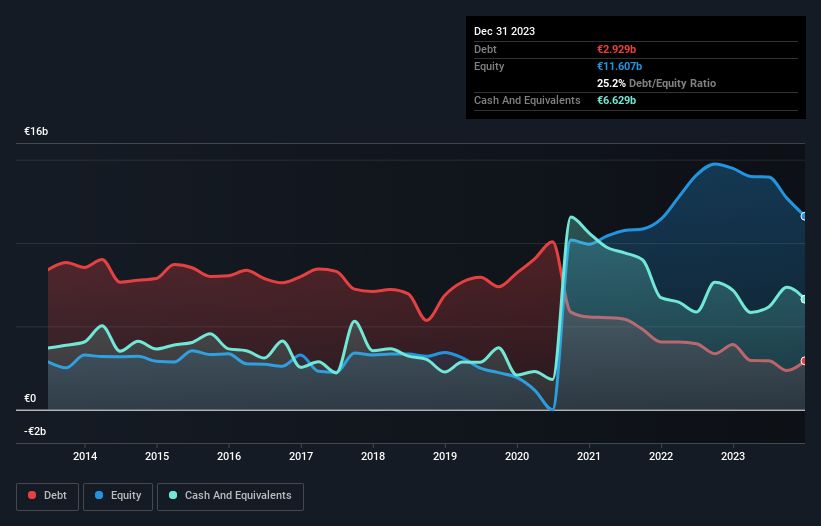
Warren Buffett famously said, 'Volatility is far from synonymous with risk.' So it seems the smart money knows that debt - which is usually involved in bankruptcies - is a very important factor, when you assess how risky a company is. We note that thyssenkrupp AG (ETR:TKA) does have debt on its balance sheet. But the real question is whether this debt is making the company risky.
What Risk Does Debt Bring?
Debt assists a business until the business has trouble paying it off, either with new capital or with free cash flow. Ultimately, if the company can't fulfill its legal obligations to repay debt, shareholders could walk away with nothing. However, a more frequent (but still costly) occurrence is where a company must issue shares at bargain-basement prices, permanently diluting shareholders, just to shore up its balance sheet. Of course, the upside of debt is that it often represents cheap capital, especially when it replaces dilution in a company with the ability to reinvest at high rates of return. When we think about a company's use of debt, we first look at cash and debt together.
See our latest analysis for thyssenkrupp
What Is thyssenkrupp's Net Debt?
The image below, which you can click on for greater detail, shows that thyssenkrupp had debt of €2.93b at the end of December 2023, a reduction from €3.91b over a year. However, it does have €6.63b in cash offsetting this, leading to net cash of €3.70b.

How Healthy Is thyssenkrupp's Balance Sheet?
The latest balance sheet data shows that thyssenkrupp had liabilities of €12.4b due within a year, and liabilities of €8.04b falling due after that. Offsetting this, it had €6.63b in cash and €5.96b in receivables that were due within 12 months. So it has liabilities totalling €7.87b more than its cash and near-term receivables, combined.
This deficit casts a shadow over the €2.95b company, like a colossus towering over mere mortals. So we definitely think shareholders need to watch this one closely. After all, thyssenkrupp would likely require a major re-capitalisation if it had to pay its creditors today. Given that thyssenkrupp has more cash than debt, we're pretty confident it can handle its debt, despite the fact that it has a lot of liabilities in total. The balance sheet is clearly the area to focus on when you are analysing debt. But it is future earnings, more than anything, that will determine thyssenkrupp's ability to maintain a healthy balance sheet going forward. So if you want to see what the professionals think, you might find this free report on analyst profit forecasts to be interesting.
Over 12 months, thyssenkrupp made a loss at the EBIT level, and saw its revenue drop to €37b, which is a fall of 11%. That's not what we would hope to see.
So How Risky Is thyssenkrupp?
Statistically speaking companies that lose money are riskier than those that make money. And the fact is that over the last twelve months thyssenkrupp lost money at the earnings before interest and tax (EBIT) line. Indeed, in that time it burnt through €56m of cash and made a loss of €2.5b. With only €3.70b on the balance sheet, it would appear that its going to need to raise capital again soon. Summing up, we're a little skeptical of this one, as it seems fairly risky in the absence of free cashflow. When analysing debt levels, the balance sheet is the obvious place to start. However, not all investment risk resides within the balance sheet - far from it. We've identified 1 warning sign with thyssenkrupp , and understanding them should be part of your investment process.
If you're interested in investing in businesses that can grow profits without the burden of debt, then check out this free list of growing businesses that have net cash on the balance sheet.
New: Manage All Your Stock Portfolios in One Place
We've created the ultimate portfolio companion for stock investors, and it's free.
• Connect an unlimited number of Portfolios and see your total in one currency
• Be alerted to new Warning Signs or Risks via email or mobile
• Track the Fair Value of your stocks
Have feedback on this article? Concerned about the content? Get in touch with us directly. Alternatively, email editorial-team (at) simplywallst.com.
This article by Simply Wall St is general in nature. We provide commentary based on historical data and analyst forecasts only using an unbiased methodology and our articles are not intended to be financial advice. It does not constitute a recommendation to buy or sell any stock, and does not take account of your objectives, or your financial situation. We aim to bring you long-term focused analysis driven by fundamental data. Note that our analysis may not factor in the latest price-sensitive company announcements or qualitative material. Simply Wall St has no position in any stocks mentioned.
About XTRA:TKA
thyssenkrupp
Operates as an industrial and technology company in Germany and internationally.
Undervalued with excellent balance sheet.
Similar Companies
Market Insights
Community Narratives



